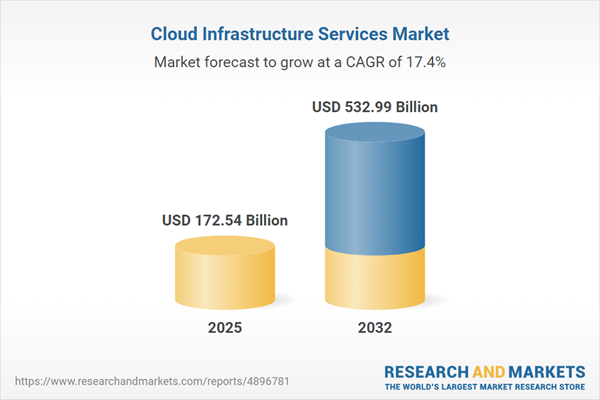Speak directly to the analyst to clarify any post sales queries you may have.
Cloud infrastructure services are pivotal for organizations seeking agility, scalability, and operational efficiency in a continually evolving digital landscape. Senior executives recognize these services as essential for building competitive, resilient, and future-ready enterprise technology strategies.
Market Snapshot: Cloud Infrastructure Services Market Overview
The Cloud Infrastructure Services Market experienced robust expansion, growing from USD 147.29 billion in 2024 to USD 172.54 billion in 2025 and is projected to continue at a CAGR of 17.44%, reaching USD 532.99 billion by 2032. This trajectory reflects surging enterprise adoption across sectors, increased investment in advanced technologies, and a strong global appetite for infrastructure as a service.
Scope & Segmentation of the Cloud Infrastructure Services Market
- Deployment Models: Hybrid, Private, and Public Cloud
- Component Offerings: Infrastructure as a Service (including Compute, Network, Storage); Platform as a Service (Analytics as a Service, Application Development as a Service, Database as a Service)
- Compute Types: Bare Metal, Virtual Machines
- Network Services: Load Balancer, Virtual Network
- Storage Solutions: Block Storage, File Storage, Object Storage
- Analytics Services: Big Data Analytics, Real-Time Analytics
- Application Development Platforms: Container Platform as a Service, Serverless Computing as a Service
- Database Options: NoSQL Database as a Service, Relational Database as a Service
- Organization Sizes: Large, Medium, and Small Enterprises
- Industries Addressed: BFSI, Government & Public Sector, Healthcare, IT & Telecom, Manufacturing, Retail & ECommerce
- Regional Coverage: Americas (including North America and Latin America), Europe, Middle East & Africa, Asia-Pacific
Key Takeaways for Senior Decision-Makers
- Hybrid and distributed architectures are enabling seamless integration of private and public cloud resources, aligning flexibility with enterprise control requirements.
- Cloud security remains front-of-mind, prompting providers to integrate advanced compliance frameworks, zero-trust models, and AI-driven threat detection into service portfolios.
- Edge computing and intelligent operations are transforming deployment approaches, with micro data centers and predictive analytics expanding service reach and efficiency.
- Sustainable infrastructure investments and renewable energy commitments are increasingly influencing vendor selection and enterprise procurement policies.
- Pricing models have diversified to align closely with evolving consumption patterns, supporting finance and IT leaders in governance and resource optimization.
- Multi-cloud governance and operational streamlining remain vital for organizations managing complex portfolios and responding rapidly to business needs.
Tariff Impact: Navigating Supply Chain and Sourcing Shifts
Recent US tariff adjustments imposed in 2025 have reshaped sourcing strategies, particularly for hardware like servers, storage arrays, and networking equipment. Providers are responding by diversifying supply chains, establishing regional fabrication hubs, and expanding domestic data center campuses to offset increased costs and ensure compliance with data sovereignty requirements. Additionally, investments are accelerating in software-defined and virtualized alternatives, reducing reliance on hardware exposed to cost fluctuations. These strategic adjustments better equip enterprises to navigate regulatory shifts and mitigate supply chain risk.
Methodology & Data Sources
This report is built on a rigorous research methodology incorporating primary interviews with senior technology executives and procurement leaders, comprehensive secondary reviews of technical white papers, regulatory filings, and industry publications, and triangulation of quantitative data from industry surveys and internal metrics. This multi-source approach ensures balanced, actionable insights reflective of real-world market dynamics.
Why This Report Matters
- Enables executive teams to benchmark cloud adoption strategies against industry leaders and anticipate emerging trends crucial for technology planning.
- Equips procurement and IT leaders to evaluate risks and optimize infrastructure investments amid changing regulatory and market environments.
- Provides segmentation, regional dynamics, and provider analysis for granular decision-making and targeted strategy execution.
Conclusion
Senior decision-makers can leverage this report to guide cloud infrastructure strategy, ensuring resilient, compliant, and scalable operations in a rapidly transforming market. Insights provided support informed technology investment and operational agility.
Additional Product Information:
- Purchase of this report includes 1 year online access with quarterly updates.
- This report can be updated on request. Please contact our Customer Experience team using the Ask a Question widget on our website.
Table of Contents
3. Executive Summary
4. Market Overview
7. Cumulative Impact of Artificial Intelligence 2025
Companies Mentioned
The companies profiled in this Cloud Infrastructure Services market report include:- Amazon Web Services, Inc.
- Microsoft Corporation
- Google LLC
- Alibaba Group Holding Limited
- Tencent Holdings Limited
- International Business Machines Corporation
- Oracle Corporation
- Huawei Technologies Co., Ltd.
- DigitalOcean Holdings, Inc.
- OVH Groupe SAS
Table Information
| Report Attribute | Details |
|---|---|
| No. of Pages | 196 |
| Published | November 2025 |
| Forecast Period | 2025 - 2032 |
| Estimated Market Value ( USD | $ 172.54 Billion |
| Forecasted Market Value ( USD | $ 532.99 Billion |
| Compound Annual Growth Rate | 17.4% |
| Regions Covered | Global |
| No. of Companies Mentioned | 11 |









